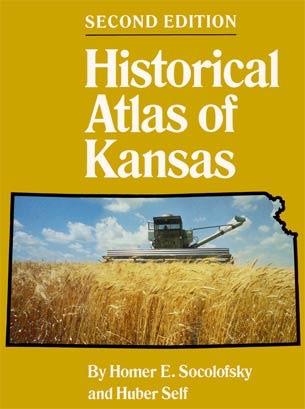Reading Tyler Clark’s college paper “Warriors of White Rock … 1862-1926” took me back. Not back to 1862 or even 1926, but to 1974, a date I’ll get to in a moment.
A few days ago I took up so much space complaining about one of Clark’s sources that I mentioned few of the virtues of his paper, among them a small but well-chosen group of illustrations. These include a photograph of a 1913 Lovewell family reunion, a map from an historical atlas showing the location of the twenty townships of Republic County, and a hand-drawn layout of White Rock City which pinpoints the location of a schoolhouse, a church, and the S. E. Morlan residence. To wrap up his tale of the ghost town, Clark himself snapped a picture of the limestone marker which today is the only visible remnant of the site.

Most of the source material available to Tyler Clark when he wrote his paper was flawed and skimpy. The one exception may be “Historical Atlas of Kansas” by Homer Socolofsky and Huber Self, a pair of professors from Kansas State University who collaborated on their historical map project in the mid-1980’s. I knew Huber Self, a gentle man who seemed ancient even back when I sat jotting down notes in his class on Kansas geography many summers ago. The name Socolofsky also had a familiar ring to it, although the only history classes I can remember taking at the university were History and Politics of Ancient Greece and History of England in the 18th Century. It finally occurred to me that I probably spent an evening watching television at the Socolofsky house one evening in the summer of 1974.
I did not give Homer Socolofsky another thought until last week when I came across his name in the bibliography of Tyler Clark’s paper on White Rock City. I should probably spring for a copy of Socolofsky and Self's historical atlas, which is still in print and could have been a great help when I was trying to make sense of where things were going so terribly wrong in Kansas in the 1860’s. Both professors are gone now, but not long gone. Homer died in 2005 and Huber died five years afterward at the age of 97.
In a way, Huber Self is also the reason I live in southeast Kansas. It’s a region he talked up in his class on Kansas Geography, pointing out its comparatively mild winters and light snowfall (He might have mentioned the ice we tend to get instead). Our textbook touched on the area's mining heritage, its mined land which has been reclaimed for recreational use, and the titanic steam shovel, Big Brutus, which remains a popular tourist attraction, looming over the Kansas prairie like one of those Martian machines in “War of the Worlds.” It’s hard to miss. There was a photograph of Brutus in our textbook, along with one of the studio at the TV station where I’ve worked now for nearly forty years.

I got a new iMac to mark the anniversary. Clearing out the hard drive of an old computer and setting up a new one is a lot like getting ready to move. So many things, even virtual things, have to be weeded out eventually, but not without a fond final thumbing-through before dumping the trash. Earlier this week I came across a folder of pictures from television history that I collected for our TV station’s 50th anniversary show almost twelve years ago. One of them was titled “Corbett,” and I knew immediately what I would see before I opened it.
There was a picture of the crew of the rocket cruiser Polaris gathered around a control panel on the television show “Tom Corbett - Space Cadet.” I had downloaded it to illustrate the tangled world of network television when our station first signed on the airwaves in 1953. “Tom Corbett” took its turn on the schedules of four networks in those days, CBS, ABC, NBC and Dumont. It must have been airing on Dumont when viewers in southeast Kansas finally got a chance to catch up with it.
Long before I noticed any similarity to a young Dave Lovewell, a close look at that picture back in the fall of 2003 is what first set me to wondering if the cast member playing the role of cadet Roger Manning from 1950 to 1953 wasn’t the same actor who was often gunned down in the streets of Dodge or Laramie or Tombstone throughout the 1950’s and 60’s. That’s when I first looked up actor Jan Merlin, whose career turns out to be an encyclopedic cross-section of TV Westerns and cop shows, dotted with appearances in some A-list movies (He’s also in a “Little House” episode). The fact that almost everything ever televised seems to have been uploaded to Youtube, Western Civilization's cultural attic, gave me a chance to sample “Tom Corbett,” but I opted instead to watch the one available episode of “Roughriders,” a syndicated Western filmed at the Edgar Rice Burroughs Ranch near Tarzana and broadcast in 1958 and ’59.
Playing a dashing ex-Confederate soldier headed for the West, Merlin was one of the show’s three regulars, riding alongside minor-league leading man Kent Taylor and veteran character actor Peter Whitney. Although the story entitled An Eye for an Eye features Lon Chaney, Jr., in the thankless role of a vengeful patriarch, the episode was uploaded to honor another guest star, Allison Hayes.
It takes us back to a time when the airwaves were so full of Westerns, the networks could not hold them all.